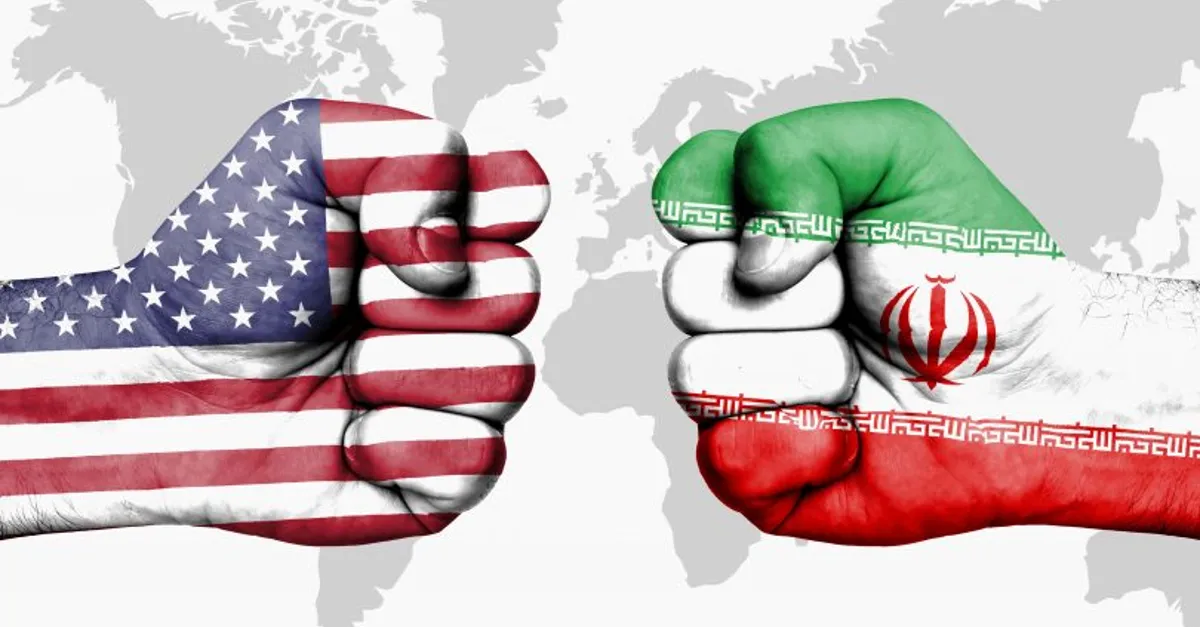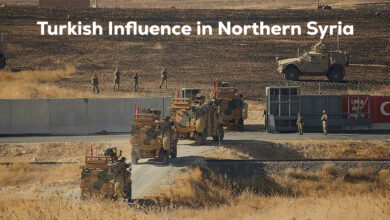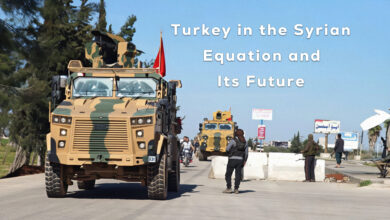
The Middle East region in general, Israel and Syria in particular, hold an important place in American foreign policy compared to other regions of the world. The economic value of the Middle East, its strategic geopolitical position and energy sources, will significantly increase American influence in the world when controlled.
U.S.’ interest in the Middle East began at the end of the eighteenth century, when the American economy required broad trade with various countries in the world.
At the beginning, Americans arrived in the Middle East as missionaries of the Christian religion. The first missionaries settled in the Levant in 1820, and then their presence evolved into the establishment of institutes and schools in 1823, followed by the founding of the American University in 1866.
With the beginning of the twentieth century, American interest in the Middle East increased through archaeologists and missionaries, as well as the migration of tens of thousands of people from Syria and the Middle East to the United States before World War I between 1914-1918. The Middle East subsequently became crucial to the U.S. and its interests in the region, especially after the establishment of the State of Israel.
Additionally, oil remains a major strategic factor that encouraged America’s interest in the Middle East and Syria, especially after it was discovered in Iraq in 1927, which meant the possibility of the existence of oil in Syria as well.
U.S.-Middle Eastern relations entered a new phase after the Sykes–Picot Agreement, especially after the France occupied parts of the Middle East in 1920.
After World War II, the U.S. engaged in the Middle East to deter French colonial movements. U.S. President Truman stood up against French ambitions to mandate Syria, and with America’s help Syria gained independence in 1946.
Overall, the U.S has a set of strategic reasons and objectives, though announced, in the Middle East, which are:
– The protection of Israeli interests, and substituting the Arab-Israeli conflict with the Arab-Iranian conflict.
– The protection of U.S. interests by protecting oil-producing regimes, governments and states, specifically Gulf States, continue attracting countries in the region towards the United States, and working to support political systems allied with it.
– Combating terrorist, radical and fundamentalist forces, especially ISIS and al-Qaeda, to ensure that attacks similar to September 11, 2001 do not occur again.
– Combating Russian and Iranian influence in the region and prevention of its expansion.
As a result of these objectives, the U.S. is seeking to tighten its control over the region and to establish a new Middle Eastern regional system, in which Israel takes the leadership, to redefine political characteristics of the region’s countries to become more open and democratic, and to prevent the emergence of radical powers and anti-U.S. political forces.
According to many analysts following the crises in the region, the transformations that have taken place in the Arab region (Arab Spring) are part of the construction of the new Middle East project, based on the theory of “Creative Chaos”, which is the most important pillars of U.S.’ strategy to map the new Middle East. U.S.’s alliances with Israel, Saudi Arabia and Turkey fall in line this strategy.
U.S.-Israel alliance
Israel was certainly produced by Britain, which is why it was supported and backed by Western countries, particularly the U.S., which shifted the balance in the Arab-Israeli conflict. Israel proved itself to be a regional force capable of serving American and Western interests. This is the underlying reason for U.S.’ alliance with Israel, especially during the cold war. Israel was seen as the powerful wall against Soviet influence in the Middle East. Although the world changed after the collapse of the Soviet Union, the strategic logic between Israel and the U.S. has not changed. Israel remains America’s chief strategic ally in the Middle East.
The two States are cooperating on security threats, counter-terrorism in the Middle East, in addition to nuclear non-proliferation and cooperation on matters beyond traditional security issues.
Iran’s and Russia’s quest to get America out of north and east Syria:
Recently, the threat of Russia and Iran, together with that of the Syrian regime, Lebanese Hezbollah, Popular Mobilization Forces and Kata’ib Hezbollah, has clearly increased against U.S. presence in areas east of the Euphrates, Iraq and the Kurdistan Region of Iraq (KRI).
The U.S. believes Iran has a long history of harming its interests, and that Russia also supports Iran in its hostility to American interests, and violates airspace coordination protocol between the two parties.
The persistence of Iranian attacks against U.S. bases in the fields of al-Omar and Conoco (east of Euphrates) and the use of drones against American troops in Iraq, in order to expel them from Syria and Iraq (based on Russia’s, Iran’s, and the Syrian regime’s logic) is arguably evident, and began to escalate after the Gaza war.
In this regard, The Washington Post published a report in early June containing classified documents that showed an Iranian plan to attack Americans in Syria.
In a report issued by the al-Monitor, a senior U.S. official said he saw indications that Russian military commanders in Syria were quietly coordinating with Iran’s Islamic Revolutionary Guard Corps (IRGC) on a plan to pressure the U.S. to withdraw its troops from Syria.
The Public Affairs Officer in the United States Air Force Central (AFCENT), Teresa L. Sullivan, said:
Russian aircraft have been operating in Syria for some time in an “unsafe and unprofessional” manner.
Continuous tension between U.S. and “Iran axis”:
The important question drawing the world’s attention is:
Why did the U.S. transfer military reinforcements, thousands of Marines, dozens of destroyers, battleships and aircraft carriers to the Middle East and Syria at this particular time; that is, after the events on October 7, 2023 in Gaza?
There is no doubt that tension between the U.S. and Iran surged after the Gaza War to an unprecedented level. Iran’s allies are pursuing a policy of gradual attacks against U.S. troops until the time of the U.S. elections. There are growing signs that Iran is pushing its proxies in the region to expand the war, according to the British magazine The Economist.
The Economist described the Middle East as being on the brink of war, indicating that Israel’s four borders witness tension, Hezbollah from the north, Syria, Iranian militias, and Iraqi PMF from the east, Gaza from the south, Houthi missiles from Yemen… etc.
I believe Iran’s direct involvement as a State in the conflict between Israel and Hamas is currently excluded. Iran recognizes that any intervention in the conflict will put it in a direct confrontation with the U.S. and the West and that Israel will destroy its military capabilities. Moreover, Iran’s allies – especially Russia and China – will not take its side for reasons related to their strategic interests.
Limited and gradual attacks by U.S. proxies spare Iran from entering a direct confrontation with the U.S. However, if confidential negotiations between the U.S. and Iran on how to end the war in Gaza fail, as the British website Middle East reported that senior Saudi officials were transmitting messages between Iran and the U.S., the war would then expand. The war will not be limited to only Hamas, Lebanese Hezbollah and the Houthis in Yemen, as Iraq was also a candidate to enter the military conflict. Thus, the situation between the two sides becomes open to all possibilities, such as striking Iran in its territory, sparking the Sunni issue of Iraq, and that of Kirkuk with KRI, and promoting and renewing the idea of KRI’s independence.
But, I think, the issue of an all-out war against Iran and its allies and militias in Syria is currently unlikely, and President Biden will not take this step for several reasons, most importantly:
– The upcoming elections. The President is concerned with pacifying the situation in Syria and the Middle East more than ever.
– The U.S. is mainly preoccupied and engaged in the Russian-Ukrainian war.
– The Chinese threat to U.S. security and interests, which it believes is not too far away.
If the all-out war against Iran and its militias in Iraq, Syria, Lebanon, and Yemen is currently unlikely, then what is the purpose of all this military buildup and deployment of American troops?
The answer to this question is not easy, but there is a possible scenario regarding Iran and its proxies in the region, in addition to a series of messages addressed to adversaries, friends and allies in the Middle East, which are:
Possible scenario on Iran: In the first phase, the U.S. responds to Iran and its proxies in the region according to the damage it inflicts on them or slightly more (reactive policy). If Iran and its proxies crosses the red line (striking U.S. battleships, troops, and Israel with ballistic missiles from inside Iran), then both the U.S. and Israel will hit Iranian territory and nuclear facilities with formidable strikes. The elimination of Iran’s proxies and militias in Syria, Iraq and Yemen, and Hezbollah in Lebanon will be among the most important objectives of the deployed U.S. forces.
There are messages for adversaries, friends and allies:
– For adversaries:
The U.S. wants to send a strong message to Russia to abide by the airspace coordination protocol within Syrian territory, and not violate the borders of the agreements signed between them with regard to Syria.
– For allies and friends:
The U.S. wants to put pressure on its allies and old friends in Saudi Arabia and the Gulf, that it is committed to its alliances with them by striking the Houthis, protecting oil tankers across the Gulf, and that they have to halt their inclination towards reconciliation with Iran and Syria… etc.
Possible consequences of Operation “Iron Swords” (Israel’s war against Gaza) on Iran and its proxies:
Israel launched Operation “Iron Swords” on October 8, 2023, promising Hamas it will pay a heavy price for its attack on Israel on October 7, 2023. On the other hand, Iran is employing the Operation to strengthen its position as a regional actor hard to neglect.
Despite its concern to avoid war, Iran is faced with the following poor conditions:
– Hamas – its ally – is being destroyed before its eyes without being able to intervene to save it from Israel’s swords. This reduces Iran’s prestige and credibility, and weakens its resistance forces.
– The likelihood of a war between Israel and Hezbollah in Lebanon increases that may result in the destruction of Hezbollah’s capabilities that were invested by Iran in the long term. This could lead to Iran being forced into war, which is not in its favor.
– Israel’s victory in Gaza will inevitably strengthen the alliances between Israel and Arab States, and it would thus lead to Iran’s exclusion from the region as an important actor and its isolation from its Arab surroundings.
– If Hamas and Lebanese Hezbollah lose the war against Israel, that will be the beginning of Iran’s collapse in the Middle East.




